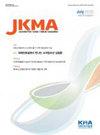髌股关节不稳的诊断与治疗
IF 0.3
Q3 MEDICINE, GENERAL & INTERNAL
引用次数: 0
摘要
背景:髌骨不稳,根据定义,是髌骨病理性脱离髌骨关节,通过半脱位或完全脱位。髌骨不稳定的总发生率在每10万人5.8 - 29人之间。随着时间的推移,患有髌骨不稳定的患者会出现使人衰弱的疼痛、基本功能受限和长期关节炎。当前概念:髌股不稳定的危险因素包括滑车发育不良、髌骨高位、胫骨结节到滑车沟距离增加、髌骨外侧倾斜异常、冠状和扭转排列异常。正确的治疗方法常常是有争议的。保守治疗适用于急性脱位,但对于慢性不稳定的脱位失败率高,通常需要手术治疗。今天常见的外科治疗侧重于修复解剖缺陷,缓解不稳定症状,并使患者恢复到适当的活动水平。讨论与结论:在这篇综述中,我们总结了髌股不稳的相关病理生理、分类、临床特征、体格检查、影像学和治疗方案。本文章由计算机程序翻译,如有差异,请以英文原文为准。
Diagnosis and treatment of patellofemoral joint instability
Background: Patellofemoral instability, by definition, is a condition where the patella bone pathologically disarticulates out from the patellofemoral joint, either through subluxation or complete dislocation. The overall incidence of patellofemoral instability ranges between 5.8 and 29 per 100,000. Over time, patients with patellar instability can have debilitating pain, limitations in basic function, and long-term arthritis.Current Concepts: Risk factors for patellofemoral instability include trochlear dysplasia, patella alta, increased tibial tubercle-to-trochlear groove distance, abnormal patella lateral tilt, and coronal and torsional malalignment. The proper treatment is often debatable. Conservative treatment is suitable for acute dislocation but has a high failure rate for chronic instability, which usually necessitates surgical treatment. Today’s common surgical treatments focus on fixing anatomical defects, relieving symptoms of instability, and allowing patients to return to a suitable level of activity.Discussion and Conclusion: In this review, we summarize the relevant pathophysiology, categorization, clinical features, physical examination, imaging, and treatment options for patellofemoral instability.
求助全文
通过发布文献求助,成功后即可免费获取论文全文。
去求助
来源期刊

Journal of The Korean Medical Association
Medicine-General Medicine
CiteScore
0.50
自引率
0.00%
发文量
84
审稿时长
4-8 weeks
期刊介绍:
The Journal of the Korean Medical Association (JKMA) is the official peer-reviewed, open-access, monthly journal of the Korean Medical Association (KMA). It contains articles in Korean or English. Its abbreviated title is ''J Korean Med Assoc''. The aims of the Journal include contributing to the treatment of and preventing diseases of public health importance and to improvement of health and quality of life through sharing the state-of the-art scientific information on medicine by the members of KMA and other national and international societies.
 求助内容:
求助内容: 应助结果提醒方式:
应助结果提醒方式:


